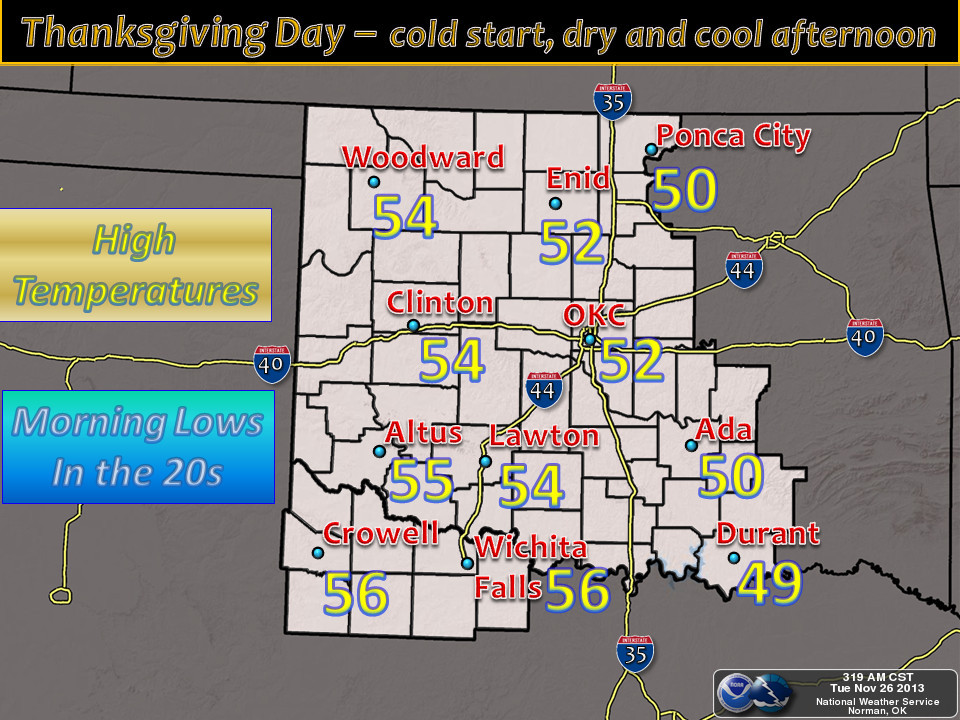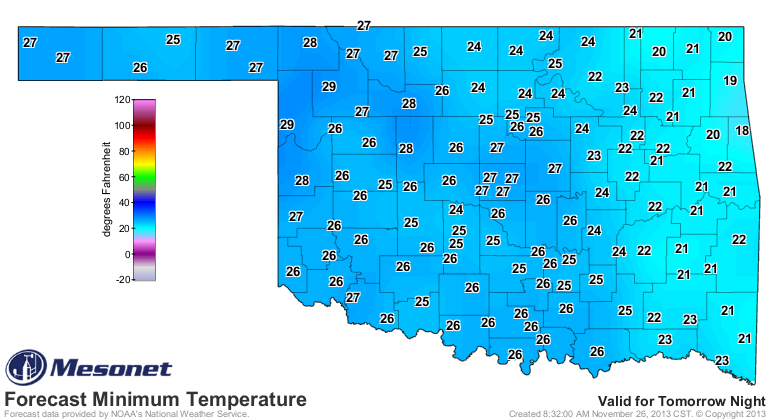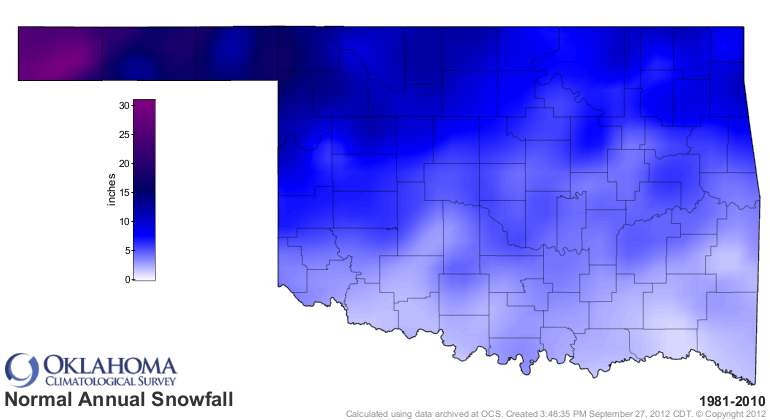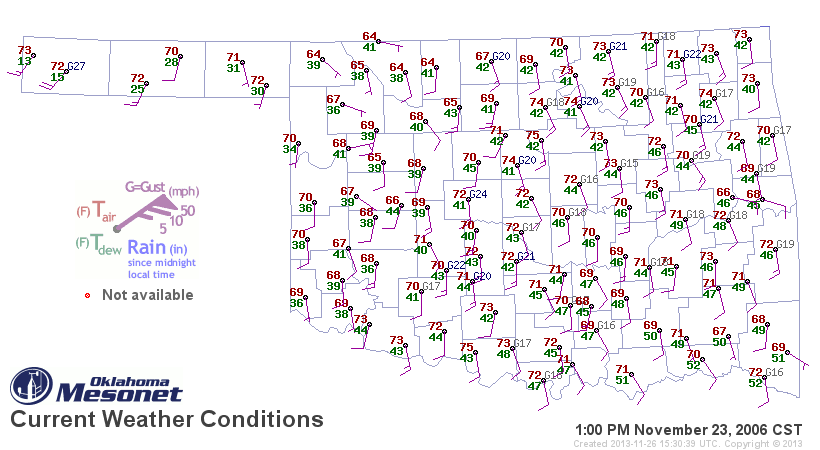Ticker for November 26, 2013
MESONET TICKER ... MESONET TICKER ... MESONET TICKER ... MESONET TICKER ...
November 26, 2013 November 26, 2013 November 26, 2013 November 26, 2013
Ghosts of Thanksgivings Past
We definitely dodged the Thanksgiving holiday travel bullet with last weekend's
storm system. It would not have been a pretty picture had we forwarded that storm
about 5 days ahead, but now it's the eastern half of the country's problem. Things
are looking good for our Turkey Day travel.



But things haven't always gone so smoothly here in Oklahoma around Thanksgiving
holiday, and some of the worst travel conditions for that holiday have occurred
within most of our lifetimes (even saying "most" there means we are all getting
older, and some of us more so than others!).
My own reminiscing brought me back to a time I was but a young lad in school here
at OU, awaiting the results of a test in Dr. Claude Duchon's Advanced Time Series
Analysis graduate class. It was Tuesday, November 24, 1992. A very powerful
storm system was moving in from the west, promising heavy snow, sleet and freezing
rain. The system had been talked about for more than a week and I had become more
and more agitated as I realized I was going to be trying to race it home to
Buffalo ... me from the east and it from the west. As I sat in that morning
class, I had just come from the School of Meteorology's computer room (no smart
phones back then!) where I had seen reports of freezing rain and sleet in the
Panhandle and northwest already.
Now the thought of my prospects of spending Thanksgiving alone in Norman was
enough to send me into action. I told Dr. Duchon "thanks, but no thanks!" on
going over the test (grade redacted to protect the sanctity of my reputation)
and headed out the door towards Buffalo. They say Okies can't drive in the snow,
but I always claim the folks from up in the northwest where 2-3 feet of snow
falls each year are the exception.

Up there, where the cedar trees greatly outnumber the population, you learn to
drive in the snow or you end up stranded for a few days in a snow drift. The
kicker to my story is that I owned a 5.0 Mustang GT with wide tires at the time.
A wonderful car when roads are dry with it's rear wheel drive and inability to
jump like a jackrabbit when you hit the gas pedal, but not so great when snow
or ice are involved. I made it to about Watonga when the sleet and snow hit, and
by the time I made it to Woodward, they had closed highway 270 going west of
town towards Buffalo thanks to a half-inch layer of ice covered by a foot of
snow, being drifted by 40 mph winds. Yeah, you guessed it ... I drove right
through those Road Closed signs. Hey, I was young and stupid AND I wasn't going
to miss Thanksgiving at home. So through the signs I go on my merry way. Now the
trick to driving in snow and ice is to never touch the gas or breaks. Just let
the wind push you wherever you're going. Now that works fine until you're trying
to get your Mustang GT with the rear wheel drive up a steep hill south of
Buffalo. The more I pushed on the gas, the more I slowed down until finally, I
was stopped. So close, but so far. Luckily, an ODoT worker came up behind me
and having recognized me, he pushed me up the hill in his truck without even
cursing me and my stupidity to my face.
I pulled into my family's house finally, 5 hours (normally a 3-hour drive)
after I started. By the time the storm was over, Buffalo would have 16 inches
of snow, Gate just to the west of Buffalo would have 22 inches, and Laverne
came in with 19 inches. And that wasn't counting the drifts, mind you. Some of
the news reports from the day tell just how bad the conditions were, such as
this snippet from the A.P.:
"National Guardsmen on Wednesday rescued Thanksgiving travelers stranded
on snow-covered highways after a deadly blizzard dumped more than a foot
of snow in parts of Colorado, Texas, Oklahoma and Kansas. Major highways
across western Texas that had been closed by snow drifts up to six feet
deep began to reopen, but heavy snow and strong wind shut roads in
western Kansas. In Elmwood, Okla., the Highway Patrol sent out two
four-wheel drive vehicles and found at least 20 vehicles, some carrying
children, on a road that was closed Tuesday."
Lucky, on my part? I call it skill! But yes, I was as lucky as I was stupid.
The bad Thanksgiving travel weather came back the following year when an upper-
level storm moved over the state on Nov. 25, 1993, dumping up to 2 inches of
freezing rain and sleet across southern and eastern Oklahoma. As many as five
motorists were killed on the highways that Thanksgiving while traveling in the
icy conditions.
Being the warm weather aficionado that I am, I much prefer the Thanksgiving
weather of 2006. Highs that Thanksgiving Day of November 23 rose into the 70s
across nearly the entire state. The biggest travel hazard that day was a
radiator boiling over, no doubt. This is what the Mesonet map looked like as
many of you were sitting down to dinner about 1pm or so ... light winds and
low 70s. Naps? That's football outside weather. Work off some of those pounds
so you can come in for more!

Thanksgiving in what is now Oklahoma has its dark memories as well, as recounted
by former Associate State Climatologist Howard Johnson. Thanksgiving Day in
1868 was declared to be on the 26th of November by then-President Andrew
Johnson in Proclamation 178:
"I therefore recommend that Thursday, the 26th day of November next, be
set apart and observed by all the people of the United States as a day
for public praise, thanksgiving, and prayer to the Almighty Creator and
Divine Ruler of the Universe, by whose ever-watchful, merciful, and
gracious providence alone states and nations, no less than families and
individual men, do live and move and have their being."
As noted by Howard Johnson, this is also the date of one of the United States'
(in territory that would eventually become Oklahoma) most infamous Native
American battles (some would say massacre).
"History recounts that on November 26 and 27, 1868, elements of the 7th
U.S. Cavalry, commanded by George A. Custer, marched overnight under
cover of a snowstorm from Fort Supply to the Washita River in extreme
western Oklahoma to launch a sunrise attack on a village of Cheyenne
Indians. Black Kettle, the Cheyenne chief who considered his band to
be at peace with the Army, was killed in the assault for which his
village was unprepared."
This occurred near what is now Cheyenne, Oklahoma, and is now home of the
Washita Battle National Historic Site.
By the way, I'll be traveling west in a mini-van this year. Not quite the
Mustang GT of my youth, but at least I won't need a push up a hill to get there!
Gary McManus
Associate State Climatologist
Oklahoma Climatological Survey
(405) 325-2253
gmcmanus@mesonet.org
November 26 in Mesonet History
| Record | Value | Station | Year |
|---|---|---|---|
| Maximum Temperature | 80°F | NEWP | 2019 |
| Minimum Temperature | 8°F | KENT | 2010 |
| Maximum Rainfall | 2.61″ | COPA | 2015 |
Mesonet records begin in 1994.
Search by Date
If you're a bit off, don't worry, because just like horseshoes, “almost” counts on the Ticker website!